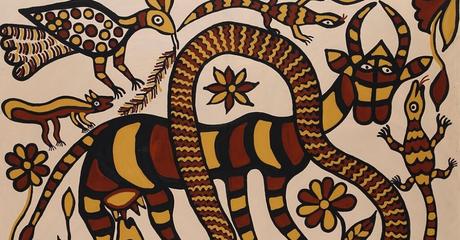
Sohrai is a harvest festival celebrated in the state of Jharkhand as well as in the neighboring states of Bihar, Chattisgarh, Odisha, and West Bengal by the Prajapati, Kurmi, Santal, Munda, and Oraons tribes on the day of Amavasya in the Hindu month of Karthik which is during the month of October - November.
The festival is all about colors, paintings, and foods. The women of the family freshly paint the walls of their mud houses with Sohrai paintings, light earthen lamps in the cattle sheds, and prepare a feast in the honor of cattle especially bullocks, buffalos, goats, and sheep.
Sohrai painting is considered as the state art of Jharkhand. The tribal women decorate their mud houses with Sohrai wall paintings. It is usually drawn with the help of sticks, cloth swabs, fingertips, and broken combs and depicts Pashupati (the creator of animals), flowers, elephants, peacocks, sparrows, squirrels, cows, etc.
The colors used in the paintings are extracted from flowers, leaves, plants, rice, etc, and mixed with Kali Matti (Maganese black), Duddhi Matti/ Charak Matti (white mud), Lal Matti/Geru (red oxide) and Pila Matti (yellow ochre).
Sohrai painting is a matriarchal tradition that is passed on by the mother-in-law to their daughter-in-law. Earlier it was painted in caves which later got shifted to house walls.
A specific procedure is followed while painting which makes this art unique. The wall is coated with white mud and while it remains wet the painting is made.
At first red lines are drawn which symbolizes the blood of the ancestors, procreation, and fertility. Then the black lines are drawn which signifies Lord Shiva. The outer lines are drawn next representing protection, fidelity, and chastity. At last, the white lines are drawn with a mixture of previous years harvested rice and milk which represents food.
Khovar is another age-old heritage painting originated in the Hazaribagh district of Jharkhand. The word 'Khovar' is derived from the word 'Koh' which means 'cave' and 'Var' which means 'husband'. The painting is made to decorate the marriage room of the bride and the groom and therefore, is mostly painted during the marriage season that starts from the month of January and bypasses the summer months to end at the onset of monsoon.
According to the tribal tradition, the groom pays the bride's price on the day of the marriage and spent the night in the bride's house. To decorate the marriage room of the bride-groom, the mother and aunts of the bride paint the walls with Khovar paintings.
Khovar is also a matriarchal tradition that is passed on by the mother to their daughters. Similar to the Sohrai paintings, Khovar is also painted with natural colors extracted from flowers, leaves, plants, rice, etc, which is then mixed with Kali Matti (Maganese black), Duddhi Matti/ Charak Matti (white mud), Lal Matti/Geru (red oxide) and Pila Matti (yellow ochre).
The house wall is coated with white mud first which symbolizes the 'sperm of the father'. Before the coating dries, the painting is made using the black color which symbolizes 'the darkness of the mother's womb'.
The women make the paintings by scrapping with fingers or broken combs or by using sticks and cloth swab. The art depicts the animals and birds found in the region and their relationship counterparts.
Hazaribagh is the origin of the Sohrai and Khovar painting. In Hazaribagh, there are around 10 painted villages within a radius of 50 KM and each village belongs to a different community or tribe. Therefore, the motifs and style of drawing are different in all the villages.
Mr. Bulu Imam, an environmental activist and a member of the Indian National Trust for Art and Cultural Heritage (INTACH) discovered the traditional Sohrai and Khovar painting. He is working since 1987 for the protection of tribal culture and heritage in Jharkhand.
He has received the Gandhi International Peach Award in the year 2011 at House of Lords in London, Padma Shri in the year 2019, and many other awards for his exceptional work.
In the year 1991, he discovered the rock art of Jharkhand at Isco (or Isko) and also many rock art sites in the Northern Karanpura Valley. In 1993, he discovered the Khovar and the Sohrai paintings on the walls of the tribal mud houses in villages of Hazaribagh. Later, he drafted the connection between the rock arts and the wall paintings found in Jharkhand.
Recently, the Sohrai and Khovar painting of Jharkhand got the GI ( Geographical Indication) tag by the Geographical Indications Registry headquartered in Chennai. The application was made by the Sohrai Kala Mahila Vikas Sahyog Samiti Limited which was accepted by the registry on Tuesday, 12th May 2020.
Here are 9 villages in Jharkhand which you can visit for a Shorai painting tour. From the moment you enter these villages, you will discover beautifully Sohrai painted mud houses.
Isco - Munda Khovar Paintings
Isco is a tribal village located in the Northern Karanpura Valley, in the Barkagaon block of the Hazaribagh district in Jharkhand, approx 15 Km from the village of Barkagaon and 30 km from the town of Hazaribagh. The village is famous for its rock art site which is believed to be existing since the Meso-Chalcolithic Era.
Read more about ISCO Rock Art Site
Isco village is a settlement for Munda tribes who have there own unique form of Khovar art. The motifs seen in Isco are of the extinct rhinoceros, human figures, bulls, wild cattle, mandalas, cryptic writings, and pictograms that are un-deciphered, sun, rainbow serpent, yoni, concentric circles, and other patterns and designs. However, now the village has more of Sohrai paintings.
Jorakath - Kurmi Khovar Paintings
Jorakath village is also located in the Barkagaon block of Hazaribagh district, 17 KM from sub-district headquarter Gondalpura, and 45 KM from the city of Hazaribagh. The village belongs to the Kurmi tribe and practices a totally different form of Khovar paintings.
The paintings are in a black and white comb-cut sgraffito style. Some of the common murals to be found are striped and spotted wheeled animals such as cattle, elephant, etc, with a horned deity standing on the back of a bull, or a tree which signifies agriculture and nature.
Bhelwara - Kurmi Sohrai Paintings
Bhelwara is another tribal village located in the Bishungarh block of Hazaribagh district. This village also belongs to the Kurmi tribe and has a completely distinguished art form than the Jorakath village.
Kurmi tribe is known for its two major forms of art, one the black and white comb cut Khovar found in Jorakat and the other is the painted Sohrai form which is found in the Bhelwara complex of villages. It is located at 45 km east of the district headquarters town of Hazaribagh, and 80 KM North East of the closest rock art site at Isco.
Daujinagar - Agaria Sohrai Paintings
Daujinagar belongs to the Agaria tribe and the painting is monochromatic, usually in the colors of black, red, yellow, and white. It is a small village located in Padma Tehsil of Hazaribagh district, located 12km away from sub-district headquarter Padma and 20km from the district the town of Hazaribagh.
Orya Chakutwa - Ghatwal Sohrai Paintings
Orya Chakutwa is a village in the Churchu block in the Hazaribagh district. It comes under Oriya Panchayath and is located 19 KM towards South from the city of Hazaribagh and 69 KM from the capital city of Ranchi.
This village belongs to the Ghatwal tribe who use the tribal paintings as a medium to tell stories. The paintings give a glimpse into the culture and tradition that existed among tribal communities for ages.
Kharati - Prajapati Khovar Paintings
Prajapati tribes or the porters inhabiting the village of Kharati mainly practice the Khovar art and use their fingers occasionally to paint. Otherwise, they generally use small fine bamboo combs that are made by the women of the house. Kharati is located in Barkagaon block in Hazaribagh district south-west of the town of Hazaribagh.
Jarwadih - Santal Sohrai Paintings
The Santhal tribe in the Jarwadih village celebrates the cattle or the Sohrai festival in the spring month by freshly painting their mud house walls with birds murals and floral paintings. Jarwadih is another village located in the Hazaribagh district.
Kenduatoli - Malhar Sohrai Paintings
Malhar tribes are the metal caster that resides in the village of Kenduatoli located in the Hazaribagh district. The tribe practices Sohrai paintings and the designs are generally florals.
Purnapani - Santal Sohrai Paintings
Purnapani located in Churchu block of Hazaribagh district also belongs to the Santal tribe and is known for its Sohrai paintings. The village is located 33 KM towards East from the town of Hazaribagh and 74 KM from the capital city of Ranchi.

